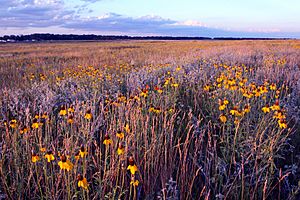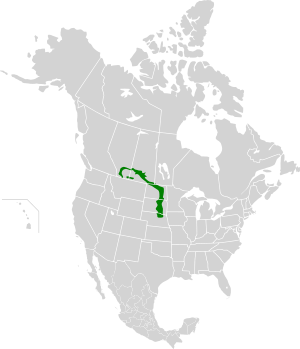Northern mixed grasslands facts for kids
Quick facts for kids Northern mixed grasslands |
|
|---|---|

A patch of mixed grassland in J. Clark Salyer NWR
|
|

Northern mixed grasslands
|
|
| Ecology | |
| Realm | Nearctic |
| Biome | Temperate grasslands, savannas, and shrublands |
| Borders |
List
|
| Bird species | ? |
| Mammal species | ? |
| Geography | |
| Country | Canada and United States |
| States/Provinces | Alberta, Saskatchewan, Manitoba, North Dakota, South Dakota, Nebraska |
| Conservation | |
| Global 200 | Yes |
| Habitat loss | 75% |
| Protected | Very low% |
The Northern Mixed Grasslands is a huge natural area. It is one of 867 special places called ecoregions around the world. The World Wide Fund for Nature helps define these areas.
This ecoregion covers parts of Canada and the United States. In Canada, it includes areas in Alberta, Saskatchewan, and Manitoba. In the US, it stretches across North Dakota, South Dakota, and Nebraska. The US Environmental Protection Agency (EPA) calls this area the Northern Glaciated Plains.
Contents
About the Northern Mixed Grasslands
This ecoregion is a special "transition zone." This means it's a place where two different types of grasslands meet. To the east, you find the Northern tall grasslands. To the west, there are the Northern short grasslands.
North of this area, the weather gets cooler. This leads to boreal forests and a much shorter time for plants to grow.
Plants of the Grasslands
The Mixed Grass prairie has plants from both tallgrass and shortgrass prairies. The main grasses you'll see here include:
- Grama (Bouteloua gracilis)
- Little bluestem (Schizachyrium scoparium)
- Needle-and-thread grass (Stipa comata)
- Wheatgrass (Agropyron smithii)
- Junegrass (Koeleria cristata)
Further north, the climate changes a bit. Here, you might find groves of quaking aspen (Populus tremuloides) and bur oak (Quercus macrocarpa). There are also mixed tall shrubs and patches of fescue grasslands. Aspen and shrubs usually grow in wetter spots. Oak and grass species prefer drier areas.
The southeast part of this ecoregion is warmer and drier. The native plants here are mostly spear grass and wheat grass. In places with salty soil, you can find alkali grass, wild barley, red samphire, and seablite.
In the Cypress Upland, which is a separate area, fescue and wheatgrass grow below 1000 meters. Higher up, you'll see mixed forests. These include lodgepole pine, deciduous trees, and shrubs. Some unique flowers like larkspur (Delphinium sp.), death camas (Zigadenus elegans), and wild lupine (Lupinus sp.) grow here. You won't find them anywhere else in the prairies.
Animals of the Grasslands
This ecoregion has many small lakes called "glacial potholes." These lakes make it the best place for waterfowl (like ducks and geese) to breed in the US.
Other animals that live in these moist mixed grasslands include:
- Black-tailed and white-tailed deer (Odocoileus hemionus and O. virginianus)
- Pronghorn antelope (Antilocapra americana)
- Coyote (Canis latrans)
- Short-horned lizard (Phrynosoma douglassi)
- Western rattlesnake (Crotalus viridis)
- Rabbits (Sylvilagus sp.)
- Sage grouse (Centrocercus urophasianus)
The Yellow-rumped warbler (Dendroica coronata) is also found only in this part of the prairies. Long ago, bison were very common here.
Challenges and Protection
This ecoregion is super important for waterfowl. Many birds use it as a place to rest and feed during their long migrations. However, it's estimated that about 80 percent of the wetlands here have been lost or damaged.
The Cypress Uplands in Alberta and Saskatchewan are part of this ecoregion. Scientists believe these uplands were not covered by ice during the last ice age.
Sadly, there are no large, completely untouched areas of habitat left. Some efforts to restore parts of the land are just starting. Only a few small sites are currently protected.

